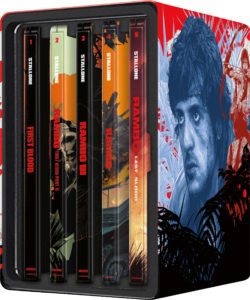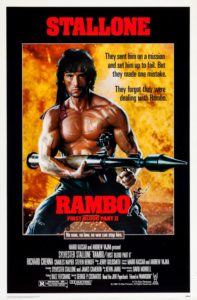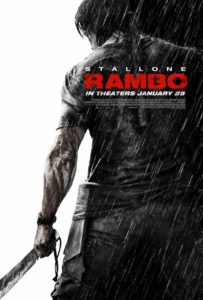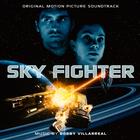The specially-packaged RAMBO: THE COMPLETE STEELBOOK COLLECTION, currently sold exclusively at Best Buy, offers Lionsgate’s 4K UHD/Blu-Ray combo packs of all five of Sylvester Stallone’s action hits – or, really, four, with a dour “Death Wish” knock-off unfortunately sharing space with the rest of the series. It’s an attractive, sturdy set that offers the best presentations of the Rambo series on home video, with ample extras and Digital HD codes to boot.
 In the context of the entire series, easily the best of the bunch is Ted Kotcheff’s 1982 introduction to the Rambo character, FIRST BLOOD (95 mins., 1982, R), which is lower-key and far more believable than the comic-book shenanigans that followed in its sequels. Here, Stallone plays Rambo as a disgruntled Vietnam vet who drifts into a Pacific Northwest town overseen by a dictatorial sheriff (Brian Dennehy, in an excellent performance capturing both the character’s antagonistic yet sometimes sympathetic traits). The two come to blows, but Rambo ultimately escapes from the sheriff’s clutches and hides out in the woods, where Dennehy and company are treated to a display of Rambo’s incredible survival skills and self-defense tactics.
In the context of the entire series, easily the best of the bunch is Ted Kotcheff’s 1982 introduction to the Rambo character, FIRST BLOOD (95 mins., 1982, R), which is lower-key and far more believable than the comic-book shenanigans that followed in its sequels. Here, Stallone plays Rambo as a disgruntled Vietnam vet who drifts into a Pacific Northwest town overseen by a dictatorial sheriff (Brian Dennehy, in an excellent performance capturing both the character’s antagonistic yet sometimes sympathetic traits). The two come to blows, but Rambo ultimately escapes from the sheriff’s clutches and hides out in the woods, where Dennehy and company are treated to a display of Rambo’s incredible survival skills and self-defense tactics.
Based on the novel by David Morrell, “First Blood” is just a dynamite action flick, backed by one of Jerry Goldsmith’s greatest scores. Stallone’s Rambo isn’t so much a killing machine here but a survivalist, which Dennehy’s team (including a young David Caruso) learn first-hand as Rambo dismantles the authorities one by one. William Sackheim and Stallone’s script is well-written and allows Stallone, Dennehy, and Richard Crenna — as Rambo’s sympathetic Army colonel — the ability to flesh out their characters while simultaneously enabling Kotcheff to carve out some terrific action set-pieces.
“First Blood” was written in the early ’70s and was originally developed for a handful of actors and directors — from Steve McQueen to Sam Peckinpah and Sydney Pollock — as it passed through Hollywood development hell. Finally, in the early ’80s, it fell into the lap of future Carolco heads Andy Vajna and Mario Kassar, who intended for the film to star Stallone and Kirk Douglas (in the Crenna role of Col. Trautman). Promotional campaigns vigorously promoted Douglas’ starring role, but after being on the set for a few days, the actor insisted on extensive script revisions (namely, a different fate for Rambo!) and the filmmakers reluctantly showed Douglas the door.
 The film’s intriguing behind-the-scenes history is discussed in an excellent 2002 documentary included in the “First Blood” BD extras. Then-recent interviews with Stallone, Kotcheff, Crenna, and producers Vajna and Kassar are included, along with author David Morrell, whose excellent commentary track (one of my all-time favorites) from the first DVD is reprieved here, along with Stallone’s commentary from a later release. Several deleted scenes including the original ending are also on-hand, plus a myriad of other featurettes, several of which are brand new to the U.S. market (these were included in Studio Canal’s remastered Blu-Rays from a decade or so ago, which never made it stateside).
The film’s intriguing behind-the-scenes history is discussed in an excellent 2002 documentary included in the “First Blood” BD extras. Then-recent interviews with Stallone, Kotcheff, Crenna, and producers Vajna and Kassar are included, along with author David Morrell, whose excellent commentary track (one of my all-time favorites) from the first DVD is reprieved here, along with Stallone’s commentary from a later release. Several deleted scenes including the original ending are also on-hand, plus a myriad of other featurettes, several of which are brand new to the U.S. market (these were included in Studio Canal’s remastered Blu-Rays from a decade or so ago, which never made it stateside).
Though a favorite of action fans and a financial blockbuster, I’ve never been a big admirer of RAMBO: FIRST BLOOD PART II (97 mins., 1985, R), which takes Rambo, turns him into a one-man wrecking crew, and accentuates all of the outlandish comic-book elements inherent in the material while abandoning reality altogether.
The James Cameron-Stallone script (from a Kevin Jarre story) sends Rambo back to Vietnam to rescue a handful of living American POWs still interred in prison camps. With credibility and the strong characterizations of “First Blood” thrown out the window here, “Rambo II” is just a silly guilty pleasure all the way, sustained by Jack Cardiff’s widescreen cinematography and another marvelous Goldsmith score. The maestro’s kinetic action cues are stunning and represent some of his strongest work written during one of his most productive periods.
 The movie’s no-brain script notwithstanding, Rambo nevertheless became a cultural phenomenon thanks to the film, and that aspect of the character is addressed in another strong 2002 documentary with cast/crew interviews, ported over here for the UHD/Blu-Ray release. The late George P. Cosmatos also provides a commentary that becomes a bit tedious, but will still be worth it for die-hard fans, while other extras – both archival and a few new additions – grace Lionsgate’s combo pack.
The movie’s no-brain script notwithstanding, Rambo nevertheless became a cultural phenomenon thanks to the film, and that aspect of the character is addressed in another strong 2002 documentary with cast/crew interviews, ported over here for the UHD/Blu-Ray release. The late George P. Cosmatos also provides a commentary that becomes a bit tedious, but will still be worth it for die-hard fans, while other extras – both archival and a few new additions – grace Lionsgate’s combo pack.
The developments in Afghanistan and the world post-9/11 have given the underrated RAMBO III (102 mins., 1988, R) a reason for rediscovery.
The troubled 1988 sequel (and box-office under-achiever) has Rambo venturing into war-torn Afghanistan in a one-man attempt to find Col. Trautman, who has been captured by the Soviets. In the Stallone-Sheldon Lettich script, Rambo allies himself with Afghan freedom fighters as he tracks down and wipes out the Russians — a story line that was already dated by the time the movie was released (with the U.S. and Russia having established a diplomatic line of communication), and is, of course, even more dated now, since the kind of freedom fighters portrayed here ended up becoming part of the Taliban regime many years later.
As purely a piece of action filmmaking, though, “Rambo III” is certainly no worse than its predecessor and is actually an improvement in terms of pacing. Russell Mulcahy (“Highlander”) was the film’s original director but was fired a few days into shooting, replaced by 2nd unit director Peter MacDonald. Despite the friction behind the scenes, and some haphazard editing (which does no favors for Jerry Goldsmith’s heavily-truncated score), “Rambo III” is still solid entertainment, a nice farewell (or so it seemed) to the character and an unofficial end-of-an-era for one-man-wrecking-crew, ’80s action filmmaking — a genre that would be altered, and revived, with the release of “Die Hard” a few months after the picture’s opening.
 The half-hour, 2002 documentary on “Rambo III” — thankfully carried over here — is excellent since it not only touches upon the logistical nightmares of the film’s production, but also the historical aspect of the setting, featuring interviews with historians and professors, all of whom discuss how the 1988 film relates to Afghanistan in the 21st century. One professor talks about how none of the movie’s Afghan accents are realistic, while there’s some enlightening discussion about how the film’s Afghan protagonists would have fit into the Taliban some time later. Peter MacDonald also contributes a commentary track ported over from prior releases, with a host of deleted scenes and other supplemental materials round out the release.
The half-hour, 2002 documentary on “Rambo III” — thankfully carried over here — is excellent since it not only touches upon the logistical nightmares of the film’s production, but also the historical aspect of the setting, featuring interviews with historians and professors, all of whom discuss how the 1988 film relates to Afghanistan in the 21st century. One professor talks about how none of the movie’s Afghan accents are realistic, while there’s some enlightening discussion about how the film’s Afghan protagonists would have fit into the Taliban some time later. Peter MacDonald also contributes a commentary track ported over from prior releases, with a host of deleted scenes and other supplemental materials round out the release.
While the included Blu-Rays for “Rambo” 1-3 are all remastered (2.35 AVC encoded transfers, 5.1 DTS MA sound, new/additional supplements) in comparison with their earlier Lionsgate format packages, the main draw, of course, are the 4K UHD transfers with HDR10 capability.
Visually, at least, they are superb if not occasionally stunning: colors appear better balanced than prior transfers, details are pleasingly crisp, and in each case, the 4K transfers best their Blu-Ray counterparts on the whole. The downside are the limited audio options – in this instance, just the 5.1 DTS MA remixes for each film are included, which are center/front heavy, and appear to have had their dynamic range curtailed from their source elements. This pertains most specifically to “Rambo II,” which is nearly monophonic in sections compared to its 2-channel source. The DVDs and the overseas Studio Canal Blu-Rays offered each picture’s robust, original 2.0 stereo tracks, which, when played back in surround, employed plenty of activity across the entire sound field. No such luck exists with these 5.1 tracks, though it’s less of an issue with the 1st and 3rd installments.








After a long lay off, Stallone returned for the uncompromisingly violent, thrilling RAMBO (91/98 mins., 2008, R/Unrated), titled “John Rambo” overseas. Presented in both its R-rated theatrical version and more nuanced, not-quite-as-graphic Extended Cut, Lionsgate’s 4K UHD houses a superlative presentation of one of Sly’s most satisfying efforts.
 The film itself is a gripping, visceral action ride, another notch in the early 21st century Stallone “Comeback Tour” that began with the superb “Rocky Balboa.” This fourth outing in the series finds Rambo making a living by hunting and selling cobras in Thailand until a group of American missionaries come looking for help. Needing Rambo’s boat in order to take them up river into Burma where the Karen people (many of which are Christian) are routinely slaughtered in a still on-going genocide, the missionaries (including cute Julie Benz and “24” vet Paul Schulze) think they’re going to make a difference. To Rambo, their naivete is surpassed only by their lack of weaponry — and our gruff hero ends up unsurprised once the group is captured in a brutal attack that slaughters nearly the entire village they were providing relief for.
The film itself is a gripping, visceral action ride, another notch in the early 21st century Stallone “Comeback Tour” that began with the superb “Rocky Balboa.” This fourth outing in the series finds Rambo making a living by hunting and selling cobras in Thailand until a group of American missionaries come looking for help. Needing Rambo’s boat in order to take them up river into Burma where the Karen people (many of which are Christian) are routinely slaughtered in a still on-going genocide, the missionaries (including cute Julie Benz and “24” vet Paul Schulze) think they’re going to make a difference. To Rambo, their naivete is surpassed only by their lack of weaponry — and our gruff hero ends up unsurprised once the group is captured in a brutal attack that slaughters nearly the entire village they were providing relief for.
“Rambo” doesn’t offer much plot (is there ever?) but the picture works due to its gut-punching action sequences, and make no mistake, this is a violent, graphic film that — quite unlike its second and third installments — shows the consequence of said violence, as well as takes a firm stand that there are times when it is necessary. None of it has the comic book feel of “Rambo” II or III and while this newer “Rambo” doesn’t have the strong character development of the original “First Blood” either, it’s surprising how well the film comes together. Stallone’s performance is more in-line with the John Rambo seen in the original “First Blood,” making this feel like a natural conclusion to the original 1982 action classic instead of a re-run of the more outlandish, bigger-budgeted comic books that its sequels turned out to be.
Though the theatrical cut is arguably crisper, it’s also more explicit and misses some character beats that “Rambo”’s Extended Version provides – in fact its eight added minutes and slight trims improve the picture overall. Aside from one sequence where Rambo covers up the evidence from a flotilla he destroyed, the additions aren’t action-intensive but rather character building sequences between Stallone and Julie Benz’s character. In the original cut it seemed like Rambo’s primary motivation to helping the missionaries was driven through Benz being a pretty young woman; here, there’s still some of that, but their conversations carry more of a discussion about Rambo’s past, the price of freedom and call to action that adds depth the original cut was simply lacking.
“Rambo” isn’t a classic movie but it’s nevertheless a potent piece of action filmmaking through and through — a gritty and satisfying ride that marks some of Stallone’s finest work as a director, and one case where a few minutes of added footage makes a big difference.
 Lionsgate’s 4K UHD of “Rambo” ’08 includes both cuts of the film in a Dolby Vision (2.35) enhanced HVEC transfer that offers a potent upgrade on the movie’s Blu-Ray releases. The High Dynamic Range boosts the overall look of the film with several moments that stand out because of its application, while the already-thundering sound design has been effectively rechanneled as Dolby Atmos as well. Supplements have been compiled from previous releases, including the feature-length “Production Diary” (as seen in the Extended Cut Blu-Ray) and both the deleted scenes and assorted featurettes from the theatrical cut Blu-Ray.
Lionsgate’s 4K UHD of “Rambo” ’08 includes both cuts of the film in a Dolby Vision (2.35) enhanced HVEC transfer that offers a potent upgrade on the movie’s Blu-Ray releases. The High Dynamic Range boosts the overall look of the film with several moments that stand out because of its application, while the already-thundering sound design has been effectively rechanneled as Dolby Atmos as well. Supplements have been compiled from previous releases, including the feature-length “Production Diary” (as seen in the Extended Cut Blu-Ray) and both the deleted scenes and assorted featurettes from the theatrical cut Blu-Ray.
The ’08 “Rambo” should’ve been the goodbye to the character, but financial considerations couldn’t stop Stallone from popping up in the disappointing RAMBO: LAST BLOOD (89 mins., 2019, R), a dour movie which tonally feels completely out of step with all of its predecessors. It’s almost as if Stallone slapped the Rambo name onto a character more deserving of a place in a direct-to-video “Taken” ripoff than helped to create an organic conclusion to the series.
This fifth and perhaps final adventure of John Rambo finds the Vietnam vet having settled on the family ranch in Arizona, living out his retirement while managing his internal demons…at least until the college-bound daughter of a family friend decides to go to Mexico. Hoping to reconcile with her destitute father, Gabrielle (Yvette Monreal) instead becomes the victim of a date-rape drug and is subsequently bound for a life in sex trafficking – all in one night! And that, of course, doesn’t sit well with Sylvester Stallone’s hero, especially once he stops taking his meds.
Stallone and Matt Cirulnick’s script for “Last Blood” actually starts off well, believably establishing the relationship between Rambo and Gabrielle, and Sly’s grizzled delivery comes off as a convincing extension of the same character he essayed in Ted Kotcheff’s original 1982 “First Blood.” Yet once the second half of the film kicks into gear, “Last Blood” loses its momentum and never recovers. The pacing turns completely awkward – second-billed lead Paz Vega’s character has no pay off whatsoever – while the picture commits a major narrative blunder that takes whatever emotional investment one might have in the story and chucks it out the window.
Stallone’s 2008 “Rambo” was a potent piece of action filmmaking that was understandably separated in tone and tenor from the ‘80s blockbusters that preceded it – yet still felt connected thematically with Rambo finding a “cause to fight for.” This lower-budgeted new entry, directed by Mel Gibson protégé Adrian Grunberg, offers even less of the same cinematic DNA, especially since Rambo suffers a major defeat in his quest, turning the pre-ordained bloody climax into less a piece of rousing violent triumph (like its predecessors) and more a rote rerun of “Death Wish.” Rambo runs around the underground tunnels beneath his ranch and takes out one generic Mexican cartel smuggler after another, but none of it offers any suspense or release since Rambo’s not fighting for anything other than serving the audience with a succession of ridiculously gory kills. With any triumph for Rambo gone, the movie is as empty as its hero’s mission here.
 Grunberg’s direction, meanwhile, lacks the raw visceral intensity Stallone brought to his 2008 “Rambo” outing, with his strongest cinematic trick reserved for passing-off Portugal and Bulgaria as Arizona and Mexico! Ultimately, though, Stallone’s prior entry should’ve been Rambo’s swan song – the iconic action hero was deserving of more than the limp cinematic rubble he’s finally reduced to here.
Grunberg’s direction, meanwhile, lacks the raw visceral intensity Stallone brought to his 2008 “Rambo” outing, with his strongest cinematic trick reserved for passing-off Portugal and Bulgaria as Arizona and Mexico! Ultimately, though, Stallone’s prior entry should’ve been Rambo’s swan song – the iconic action hero was deserving of more than the limp cinematic rubble he’s finally reduced to here.
Lionsgate’s 4K UHD includes a fine Dolby Vision-capable transfer (2.39) plus Dolby Atmos audio and a few Making Of materials. Note the original cut of the movie was some 13 minutes longer, with scenes restored to an Extended Cut only available on digital – a code, at least, included in this Steelbook package, sporting exclusive original art and a sturdy case housing all five titles. Other extras are minimal – just a note from Stallone accompanying the “Last Blood” extended cut code – and disc content is identical to the previous releases, yet this is still a highly attractive set that should appeal to any “Rambo” fan.
NEXT TIME: Wrapping up the holidays with Kino Lorber’s December Blu-Ray roster! Until then, don’t forget to drop in on the official Aisle Seat Message Boards and direct any emails to our email address.














